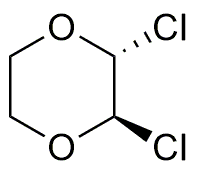trans-2,3-Dichloro-1,4-dioxane is widely utilized in research focused on:
- Solvent Applications: This compound serves as an effective solvent in organic synthesis, allowing researchers to dissolve various organic compounds efficiently, which is crucial for reaction processes.
- Intermediate in Synthesis: It acts as an important intermediate in the synthesis of pharmaceuticals and agrochemicals, facilitating the production of complex molecules with specific biological activities.
- Analytical Chemistry: Used in analytical methods, it helps in the separation and identification of compounds, making it valuable for quality control in laboratories.
- Environmental Studies: The compound is employed in studies investigating the degradation of chlorinated compounds, aiding researchers in understanding environmental impacts and remediation strategies.
- Material Science: In polymer chemistry, it is utilized in the formulation of specialty polymers, enhancing properties such as stability and resistance to environmental factors.
General Information
Properties
Safety and Regulations
Applications
trans-2,3-Dichloro-1,4-dioxane is widely utilized in research focused on:
- Solvent Applications: This compound serves as an effective solvent in organic synthesis, allowing researchers to dissolve various organic compounds efficiently, which is crucial for reaction processes.
- Intermediate in Synthesis: It acts as an important intermediate in the synthesis of pharmaceuticals and agrochemicals, facilitating the production of complex molecules with specific biological activities.
- Analytical Chemistry: Used in analytical methods, it helps in the separation and identification of compounds, making it valuable for quality control in laboratories.
- Environmental Studies: The compound is employed in studies investigating the degradation of chlorinated compounds, aiding researchers in understanding environmental impacts and remediation strategies.
- Material Science: In polymer chemistry, it is utilized in the formulation of specialty polymers, enhancing properties such as stability and resistance to environmental factors.
Documents
Safety Data Sheets (SDS)
The SDS provides comprehensive safety information on handling, storage, and disposal of the product.
Product Specification (PS)
The PS provides a comprehensive breakdown of the product’s properties, including chemical composition, physical state, purity, and storage requirements. It also details acceptable quality ranges and the product's intended applications.
Certificates of Analysis (COA)
Search for Certificates of Analysis (COA) by entering the products Lot Number. Lot and Batch Numbers can be found on a product’s label following the words ‘Lot’ or ‘Batch’.
*Catalog Number
*Lot Number
Certificates Of Origin (COO)
This COO confirms the country where the product was manufactured, and also details the materials and components used in it and whether it is derived from natural, synthetic, or other specific sources. This certificate may be required for customs, trade, and regulatory compliance.
*Catalog Number
*Lot Number
Safety Data Sheets (SDS)
The SDS provides comprehensive safety information on handling, storage, and disposal of the product.
DownloadProduct Specification (PS)
The PS provides a comprehensive breakdown of the product’s properties, including chemical composition, physical state, purity, and storage requirements. It also details acceptable quality ranges and the product's intended applications.
DownloadCertificates of Analysis (COA)
Search for Certificates of Analysis (COA) by entering the products Lot Number. Lot and Batch Numbers can be found on a product’s label following the words ‘Lot’ or ‘Batch’.
*Catalog Number
*Lot Number
Certificates Of Origin (COO)
This COO confirms the country where the product was manufactured, and also details the materials and components used in it and whether it is derived from natural, synthetic, or other specific sources. This certificate may be required for customs, trade, and regulatory compliance.


